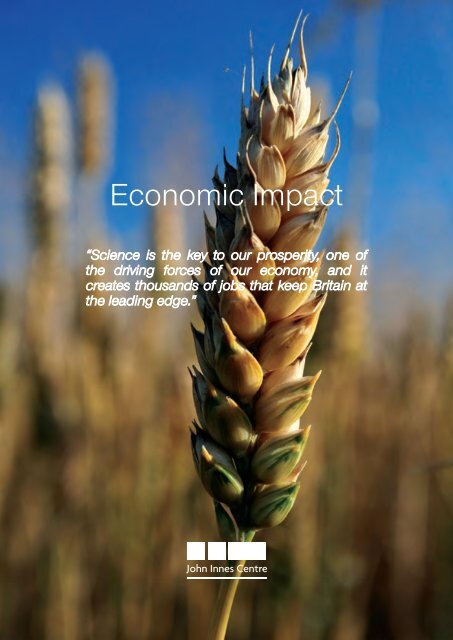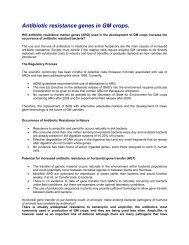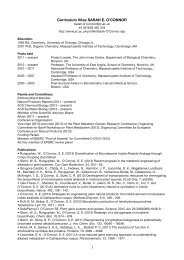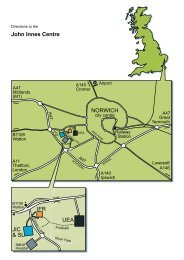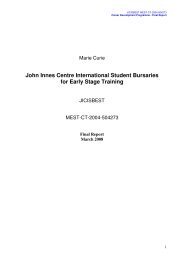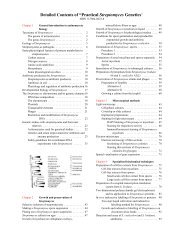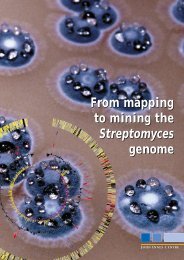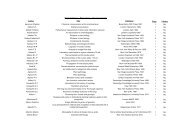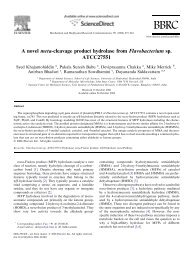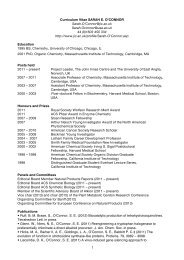Economic Impact brochure - John Innes Centre
Economic Impact brochure - John Innes Centre
Economic Impact brochure - John Innes Centre
You also want an ePaper? Increase the reach of your titles
YUMPU automatically turns print PDFs into web optimized ePapers that Google loves.
<strong>Economic</strong> <strong>Impact</strong><br />
“Science is the key to our prosperity, one of<br />
the driving forces of our economy, and it<br />
creates thousands of jobs that keep Britain at<br />
the leading edge.”
Introduction<br />
“JIC contributes over<br />
£170 million annually to<br />
the UK economy”<br />
The <strong>John</strong> <strong>Innes</strong> <strong>Centre</strong> conducts basic research<br />
into plants and microbes.<br />
Our research aims to answer key questions in<br />
biology and to provide solutions to important<br />
problems in food and energy production,<br />
promoting health and combating disease. We<br />
are able to take a long term view and have the<br />
skills and resources to make major advances in<br />
understanding that provide the foundations for<br />
achieving significant economic impact.<br />
When President Obama addressed members of<br />
the National Academy of Sciences on April 27<br />
2009 he spoke of the value of basic research:<br />
“No one can predict what new<br />
applications will be born of basic<br />
research: new treatments in our<br />
hospitals; new sources of efficient<br />
energy; new building materials;<br />
new kinds of crops more resistant<br />
to heat and drought.”<br />
This document describes some of the<br />
applications born of discoveries from basic<br />
research at the <strong>John</strong> <strong>Innes</strong> <strong>Centre</strong> and its<br />
antecedents. It attributes an estimated value<br />
to some of those applications, providing<br />
a snapshot of the economic impact of the<br />
institute’s research since it was first founded as<br />
the <strong>John</strong> <strong>Innes</strong> Horticultural Institution in 1910.<br />
Recognising the contributions made so far<br />
gives us conviction that high-quality basic<br />
research at JIC will continue to contribute<br />
to knowledge generation and to economic<br />
advancement for UK plc and world-wide. In<br />
this document we also speculate on the future<br />
impact of our current research.<br />
Working with our collaborators in academia and<br />
industry across the world, including our partner<br />
institutions on the Norwich Research Park, JIC<br />
science is directed at helping to find solutions to<br />
four of the six Grand Challenges defined by<br />
HM Treasury:<br />
• Global Food Security<br />
• Living with Environmental Change<br />
• Healthy Ageing<br />
• (Bio) Energy
!<br />
Background<br />
The JIC is a company limited by guarantee and a<br />
charity. Our benefactor and major donor is the <strong>John</strong><br />
<strong>Innes</strong> Foundation. Our principal research funder is<br />
the Biotechnology and Biological Sciences Research<br />
Council (BBSRC), together with the European<br />
Commission, and industry.<br />
In 2008, JIC commissioned Edinburgh-based<br />
consultants DTZ to estimate the overall contribution<br />
our work has made to both the UK and the global<br />
economies.<br />
“In part we asked the consultants to draw up this report<br />
in response to Treasury requests to provide evidence of<br />
economic benefits arising from our research” says Dr<br />
Steve Rawsthorne, science operations manager at JIC.<br />
ECONOMIC SNAPSHOT<br />
JIC currently contributes over £170 million to the<br />
UK economy. The worldwide economic impact is<br />
more difficult to assess, but together with applications<br />
in the pipeline, this figure is likely to rise.<br />
History<br />
The <strong>John</strong> <strong>Innes</strong> <strong>Centre</strong> as it is known today was<br />
formed from:<br />
The <strong>John</strong> <strong>Innes</strong> Horticultural Institution, 1910 – 1960<br />
<strong>John</strong> <strong>Innes</strong> Institute, 1960 – 1990<br />
The Plant Breeding Institute, 1912 – 1987<br />
The Nitrogen Fixation Laboratory, 1963 – 1995<br />
Following a bequest from Mr <strong>John</strong> <strong>Innes</strong>, a City of<br />
London merchant, William Bateson became the first<br />
director of the <strong>John</strong> <strong>Innes</strong> Horticultural Institution,<br />
later the <strong>John</strong> <strong>Innes</strong> Institute. It was the first UK centre<br />
for research in plant breeding and genetics. Bateson<br />
coined the word “genetics” and pioneered this<br />
new science.<br />
Meanwhile, PBI pioneered the application of genetic<br />
principles to breeding improved varieties of wheat.<br />
Its first director, Sir Rowland Biffen, was the first<br />
plant breeder to recognise the potential of genetic<br />
improvement for developing economically important<br />
crop characteristics. In 1906 he said in a paper, “The<br />
breeder has now to recognise that new breeds can be<br />
built up with certainty by recombining characters.”<br />
In 1987 the PBI breeding programmes and farm site<br />
were privatised and the remaining scientists joined<br />
the <strong>John</strong> <strong>Innes</strong> Institute in Norwich as part of the<br />
Institute of Plant Science Research, which included<br />
the Nitrogen Fixation Laboratory at the University of<br />
Sussex. The latter moved to Norwich in 1995 after all<br />
of these organisations were merged in 1994 to form<br />
a new organisation, the <strong>John</strong> <strong>Innes</strong> <strong>Centre</strong>. Through<br />
this process, the scientific legacy of crop genetic<br />
improvement has continued at the <strong>John</strong> <strong>Innes</strong> <strong>Centre</strong>.<br />
“We knew full well that the work<br />
we have done has an impact,<br />
but the full scale of it was a<br />
pleasant surprise.”
A century of wheat improvement<br />
Bread wheat, with an estimated world harvest of more<br />
than 550 million tonnes, is one of the most important<br />
food crops in the world. Today, the UK crop has an<br />
annual farm gate value of more than £2 billion, and<br />
is the UK’s biggest crop export. British farmers grow<br />
approximately 16 million tonnes every year and export<br />
2.5-3 million tonnes.<br />
Biffen collected different wheat varieties from around<br />
the world to develop new lines from them. In 1916, PBI<br />
released the variety “Yeoman”. British varieties, though<br />
better adapted to the UK and higher yielding, were<br />
unable to compete with foreign imports that made an<br />
aerated, fluffy loaf. Yeoman was a high yielding, strong<br />
wheat that made high quality loaves, and made a<br />
major contribution to UK food supplies in the early<br />
twentieth century.<br />
In the 1960s and 70s, a ‘Green Revolution’ in<br />
agricultural production led to large increases in yield<br />
worldwide. The main contributors to this were elite<br />
wheat crops with the Rht (reduced height) character.<br />
This reduced the amount of straw in the plant while<br />
increasing grain yield.<br />
!<br />
Breeders at the PBI were among the first to use the<br />
Rht character to develop a stunningly successful set of<br />
wheat lines that dominated UK wheat production. This<br />
material is still used by breeders in the private sector,<br />
who have continued to increase wheat yields using<br />
knowledge generated at the PBI.<br />
Scientists at the JIC identified the Rht gene itself in<br />
1998 in a major breakthrough that increased our<br />
understanding of how plant height is controlled by<br />
hormones. Recent discoveries at JIC have also shown<br />
that the Rht gene can keep plants growing in suboptimal<br />
conditions, suggesting new uses for this gene.<br />
ECONOMIC SNAPSHOT<br />
Plant breeders, initially at the PBI, have used the<br />
Rht gene to increase UK wheat production by £75<br />
million per annum. The contribution of semi-dwarfing<br />
genes to world wheat production is estimated at a<br />
staggering £3.4 billion annually.<br />
Over its 75 year history breeders at the PBI produced<br />
over 130 new varieties of wheat and other crops.<br />
The above figures are therefore just one example of its<br />
economic impact.
Wheat research in the pipeline<br />
Wheat breeding<br />
The success of wheat is partly due to its high fertility,<br />
a product of the stability of its genome. This stability is<br />
however also a barrier to introducing new traits.<br />
JIC scientists have characterised a stretch of DNA<br />
responsible for the stability of the wheat genome, called<br />
the Ph1 locus. Ph1 is the major barrier to exchanging<br />
genetic material between the chromosomes of wheat<br />
and wild species. The scientists are now investigating<br />
the possibility of temporarily switching off the Ph1<br />
locus to allow breeders to cross breed wheat with its<br />
wild relatives.<br />
This has the potential to revolutionise wheat<br />
breeding worldwide. It would open up a large pool<br />
of desirable traits to commercial cultivars such as<br />
salt tolerance, drought resistance, pest and disease<br />
resistance and increased yield. These valuable traits are<br />
otherwise unavailable.<br />
Yield<br />
Yield is a complex trait influenced by many<br />
environmental and genetic factors. It was thought that<br />
the genetic component determining yield was made up<br />
of many different genes each exerting a small influence,<br />
but recent work led by the <strong>John</strong> <strong>Innes</strong> <strong>Centre</strong> has<br />
challenged this view.<br />
Several stretches of the genome, known as quantitative<br />
trail loci (QTLs) have been identified that exert large<br />
effects on yield, in different environments. The<br />
molecular mechanisms underlying the genes are not<br />
well understood. JIC scientists are leading the effort to<br />
find the precise genetic basis for their effect on yield.<br />
As part of this effort they are collaborating with the<br />
National Institute of Agricultural Botany (NIAB) on precompetitive<br />
research to improve the genetic resources<br />
available to wheat breeders. JIC scientists are also<br />
leading work to determine the complete genetic<br />
make-up of bread wheat. This will be led by innovative<br />
applications of next generation DNA sequencing.<br />
Wheat research has a profound social and economic<br />
impact because wheat feeds 40% of the world’s<br />
population providing about 20% of the calories<br />
eaten globally.<br />
!<br />
Nitrogen fixation<br />
Plants require nitrogen, and crops require additional<br />
nitrogen to be added in the form of fertilisers. Fertilisers<br />
can increase yield by as much as 50%, but their<br />
production uses more fossil fuels than any other<br />
agricultural process. They also cause pollution when<br />
they leach into groundwater and the atmosphere.<br />
N 2<br />
O created by producing and applying nitrogenous<br />
fertilisers is the most important greenhouse gas<br />
produced by agriculture.<br />
Some plants, such as peas, source their own nitrogen<br />
by taking it from the air. These plants house bacteria in<br />
nodules on their roots. The bacteria take nitrogen from<br />
the air and convert it into a form of fixed nitrogen that<br />
plants can use. The interaction between the plant and<br />
the bacteria involves a complex system of signals.<br />
JIC scientists are working to understand these<br />
interactions and to develop new strategies to transfer<br />
nitrogen fixation to other crops. If successful these<br />
will lead to a substantial reduction in the carbon footprint<br />
of world agriculture and to the improved sustainability of<br />
crop production. Increased yields could be achieved with<br />
lower inputs.<br />
ECONOMIC SNAPSHOT<br />
Nitrogen fertiliser production consumes 1.2% of<br />
the world’s total energy on an annual basis. Extending<br />
the capacity for fixing nitrogen to maize, rice and<br />
wheat, would dramatically reduce the production<br />
costs of world agriculture.<br />
Furthermore, by reducing the dependency of crops on<br />
an oil-guzzling and expensive process, it would also help<br />
reduce the impact of oil prices on the price of food.
Combating crop diseases<br />
!<br />
Over the past 25 years, wheat production has been<br />
threatened by devastating diseases such as leaf blotch,<br />
yellow rust and eyespot. The major threats to barley<br />
have been scald and powdery mildew. These diseases<br />
cause total losses of at least £240 million per year in<br />
the UK.<br />
Focusing on one disease as an example, leaf blotch<br />
caused by the fungus Septoria tritici is a major pest<br />
to high yielding varieties of wheat. In the major wheatproducing<br />
areas of the world, outbreaks are capable of<br />
reducing yields by 30-40%.<br />
In 1998 in the UK alone, losses from this disease<br />
amounted to a cost of £35.5 million. Today Septoria<br />
tritici is by far the most damaging foliar disease<br />
for wheat.<br />
During more than a decade of collaborations with<br />
breeding companies across Europe, JIC scientists<br />
have identified wheat genes that confer resistance to<br />
Septoria tritici. As one plant breeder put it, “JIC picked<br />
a hot topic before it was hot.” This collaboration was<br />
behind the launch of the variety Alchemy in 2006,<br />
which is now the most widely grown winter wheat in<br />
the UK.<br />
Full resistance is still yet to be achieved, so the<br />
collaboration with JIC continues to combat this pest.<br />
ECONOMIC SNAPSHOT<br />
The worldwide impact on wheat production of<br />
achieving resistance to just one disease, Septoria<br />
tritici, may be as much as £4.6 billion a year.<br />
JIC is working on diseases experienced by UK farmers<br />
and farmers across the world, including the devastating<br />
‘take-all’, a fungal disease most damaging to wheat and<br />
barley crops, and Ug99, a virulent strain of stem rust<br />
that first emerged in African wheat varieties.<br />
Rusts are a global problem causing yield losses in<br />
millions of hectares annually. An estimated 37% of<br />
global wheat production is already affected by, or at<br />
potential risk from, Ug99 alone. Rusts evolve quickly to<br />
overcome resistance genes and fungicides. Scientists<br />
at JIC and The Sainsbury Laboratory on the same site<br />
are investigating ways to breed plants with broad, more<br />
long-lasting resistance.<br />
Some crop diseases are caused by insect pests that<br />
are currently controlled by insecticides. Imminent<br />
legislation will restrict the use of many insecticides,<br />
so JIC scientists are investigating how plants, insects<br />
and the diseases they transfer interact. The new<br />
knowledge gained from this work will enable new<br />
management strategies to be designed without the<br />
use of banned pesticides.<br />
The fundamental knowledge generated at JIC will also<br />
allow the agri-science community to respond rapidly<br />
to newly emerging pests and diseases.
Pea aphids
!<br />
More crop research<br />
Synteny – road maps to<br />
desirable traits<br />
Synteny is a newly coined word that means “on<br />
the same ribbon”. The ribbons are chromosomes.<br />
Chromosomes vary widely between different organisms<br />
but similar blocks of genes can be found in the same<br />
relative positions. These blocks of similarity can be<br />
used to trace evolutionary history, or to look for the<br />
genetic basis of shared traits.<br />
<strong>John</strong> <strong>Innes</strong> <strong>Centre</strong> scientists have studied the<br />
arrangement of genes in the chromosomes of cereal<br />
species. They discovered that all cereals share regions<br />
of similar gene order. This has allowed them to compare<br />
and line up genetic maps of barley, wheat, rice, maize,<br />
sorghum and millet.<br />
These ‘road maps’ to desirable traits are now part of<br />
the toolkit for research institutes across the world. They<br />
allow scientific goals to be achieved more quickly and<br />
efficiently, as required by their funders.<br />
To provide a snapshot of how this translates into<br />
economic impact, organisations such as the<br />
International Rice Research Institute in the Philippines<br />
and CIMMYT (The International Maize and Wheat<br />
Improvement Center) in Mexico use such tools to help<br />
secure funding. Their combined annual budget is<br />
around £38 million, of which £2.6 million comes from<br />
the World Bank.<br />
ECONOMIC SNAPSHOT<br />
JIC’s work on synteny can be seen to be<br />
supporting leverage of World Bank funding of £2.6<br />
million per year into IRRI and CIMMYT.<br />
!<br />
!<br />
ECONOMIC SNAPSHOT<br />
Today the £38 million annual UK dried pea market<br />
consists entirely of semi-leafless varieties. They are<br />
also used extensively across the world.<br />
Current research on peas could help breeders<br />
develop varieties able to withstand drought stress and<br />
climate change.<br />
Rapeseed<br />
Rapeseed is cultivated in rotation with cereal crops,<br />
where it plays an important role in boosting their yield<br />
in subsequent seasons. It is the second largest crop<br />
worldwide after soybean for the production of oilseeds,<br />
and the third largest source of vegetable oil.<br />
PBI scientists pioneered the development of doubled<br />
haploid lines that help plant breeders develop new<br />
varieties faster. Groups at JIC also pioneered the<br />
development of genetic maps that show the relative<br />
positions of genes controlling traits of interest. These<br />
maps provided the foundations on which all markerassisted<br />
breeding work on oilseed rape has been built.<br />
A widely-used source of resistance to the important<br />
disease Light Leaf Spot came from work at JIC.<br />
ECONOMIC SNAPSHOT<br />
The UK contributed 3.5% (2 million tonnes) of<br />
global rapeseed production in 2009 with the prices<br />
for rapeseed oil having reached $900 per tonne.<br />
Improvement to a single trait, pod shattering, could<br />
double seed yields. Scientists at JIC have identified<br />
mechanisms involved in pod-shatter, providing clues<br />
as to how it can be controlled.<br />
Peas<br />
Research and breeding at <strong>John</strong> <strong>Innes</strong> Institute (JII) in the<br />
1970s to improve the efficiency of pea harvesting led to<br />
the first registered “semi-leafless” pea varieties. Instead<br />
of leaves they have masses of intertwining tendrils that<br />
they use to hold each other up. They stand up better<br />
than more traditional varieties, are easier to harvest,<br />
have higher yields and use water more efficiently.<br />
It is too early for most of the research conducted at JIC<br />
on brassicas to have reached the marketplace, but the<br />
potential is enormous as brassicas are such important<br />
food crops.
More crop research in the pipeline<br />
Adapting crops to climate change<br />
Crop productivity is critically dependent on optimal<br />
climate. Plants respond to adverse conditions by<br />
stopping growth, leading to reduced yields and major<br />
losses to farmers.<br />
JIC scientists are uncovering the mechanisms by which<br />
plants respond, and hope to be able to alter these<br />
responses so they can continue to grow in suboptimal<br />
conditions.<br />
JIC scientists have also discovered how plants respond<br />
to over-wintering, a key agricultural trait that induces<br />
flowering the following spring. Flowering is the most<br />
important process in plant productivity. The detailed<br />
understanding of flowering built by JIC scientists in the<br />
past 20 years provides a strong foundation for adapting<br />
crops to an increasingly uncertain climate.<br />
Recently, JIC scientists discovered that plants have<br />
a built-in “thermometer” gene that controls plant<br />
responses to small temperature changes. Further<br />
research in this area will provide crucial information for<br />
breeding crops able to cope with changes in growing<br />
seasons, temperature and water availability.<br />
Making better bread and beer<br />
As well as being a major energy store in plants, starch<br />
has many uses for humans. It is the main carbohydrate<br />
of nutritional importance in the human diet. In cereal<br />
grains, starch affects the baking quality of flour and the<br />
malting quality of barley for brewing. Pure starch from<br />
flour is also used in processed foods, paint, glue, paper,<br />
cosmetics, and biodegradable packing and plastic.<br />
Each of these applications needs starches with different<br />
properties, but commercially grown wheat and barley<br />
contain starch with rather uniform properties.<br />
Scientists at the JIC and the National Institute of<br />
Agricultural Botany (NIAB) have discovered wheat and<br />
barley lines from across the globe with starches of<br />
different physical properties. They are working with<br />
end users and breeders of wheat and barley to<br />
exploit commercially interesting lines..<br />
Enriching crops<br />
Scientists at the <strong>John</strong> <strong>Innes</strong> <strong>Centre</strong> and The Sainsbury<br />
Laboratory are developing improved potato lines<br />
with elevated levels of health-promoting flavonoids.<br />
Flavonoids are natural antioxidants that are better known<br />
for their abundance in berries and other fruits.<br />
The improved lines will not only have added consumer<br />
appeal due to the health benefits, but they will improve<br />
the resistance of potatoes to late blight, giving them<br />
appeal to producers. A spin-out company called Norfolk<br />
Plant Sciences will exploit their global potential.<br />
This research follows success in increasing anthocyanin<br />
levels in tomatoes. The tomatoes increased the life<br />
expectancy of cancer-prone mice and have received<br />
worldwide attention from the media and from industry.<br />
The anthocyanins gave them a rich purple colour.
!<br />
Antibiotics<br />
Streptomyces and other actinomycetes are the world’s<br />
most important source of antibiotics, contributing<br />
over half of the current medically useful classes of<br />
antibiotics. Scientists at the JIC pioneered the discovery<br />
of genes responsible for antibiotic production in the<br />
soil bacteria Streptomyces. This work established ways<br />
to design new classes of anti-infectives that are able<br />
to combat major human diseases, including MRSA. It<br />
opens the possibility of creating designer antibiotics.<br />
JIC scientists continue to increase our understanding<br />
of how antibiotics are produced and are leaders in the<br />
commercialisation of their skills and resources. Their<br />
research supports the discovery and commercial<br />
development of new antibiotics. In 2008 the market<br />
for actinomycete-derived antibiotics was estimated at<br />
over $11 billion.<br />
Novacta, a JIC spin-out company, is working on<br />
discovering new anti-infectives that target Clostridium<br />
difficile and the superbug MRSA. It already has<br />
compounds in clinical trials. Deaths from C. difficile in<br />
England and Wales rose by 72% in just two years to<br />
reach 6,480 in 2007. A review by the National Institute<br />
of Clinical Excellence estimated the economic cost to<br />
the NHS of those deaths to be £194 million.<br />
ECONOMIC SNAPSHOT<br />
If successful, the work on anti-infective<br />
technologies could save the UK economy £194<br />
million by preventing avoidable deaths.<br />
Antibiotic<br />
research in<br />
the pipeline<br />
JIC scientists continue to pioneer research into<br />
antibiotics, and provide indispensable skills,<br />
knowledge and technologies to aid our defence<br />
against killer pathogens.<br />
They are pioneering fundamental research into an<br />
unusual class of clinically unexploited antibiotics<br />
that are active against multi-drug resistant<br />
bacteria. These studies have already led to the<br />
development of new antibiotics that are currently in<br />
clinical development.<br />
They recently discovered that a “two-headed” antibiotic<br />
molecule neatly fits into two pockets of a bacterial<br />
enzyme. This enzyme is already targeted by antibiotics<br />
but the pockets have not been previously exploited. The<br />
discovery could help companies design new antibiotic<br />
molecules with a similar structure, or help them<br />
discover other molecules that fit into the pockets.<br />
Another JIC spin-out, Procarta, is pioneering the<br />
development of a novel DNA based therapy to counter<br />
the growing problem of antibiotic resistance. The<br />
technology can also be used to extend the lifespan of<br />
existing drugs to which bacterial diseases have already<br />
developed resistance.
Research frontiers<br />
Plant viruses to produce<br />
pharmaceuticals<br />
Scientists are beginning to use plants to produce<br />
pharmaceuticals cheaply, safely, abundantly, and in<br />
a form that can be easily consumed. JIC scientists<br />
have already engineered cowpea plants to produce<br />
antibodies against a highly contagious gut virus that is<br />
particularly lethal to piglets.<br />
The same technology helped produce candidate<br />
vaccines to the H1N1 swine flu virus in just 14 days.<br />
Chief Executive of the BBSRC Professor Douglas<br />
Kell commented:<br />
“This application shows the real<br />
value of investing in basic research<br />
in the early days so that we can<br />
have useful technologies further<br />
down the line.”<br />
The virus that causes the gut disease in piglets is<br />
similar to the virus that causes Severe Acute Respiratory<br />
Syndrome (SARS). Plants could be used to quickly<br />
generate large amounts of material to provide<br />
immediate protection to healthcare workers in the<br />
event of an outbreak.<br />
Future research will look at producing cheap, reliable<br />
and convenient vaccines against other livestock<br />
diseases, including avian flu and blue tongue.<br />
Exploiting plant natural products<br />
Plants produce a huge array of natural products that<br />
they use to colonize and adapt to their environment.<br />
These diverse products are not critical for survival under<br />
laboratory conditions, but in nature they give a plant<br />
certain advantages. For example, defence compounds<br />
to fight off herbivores and diseases, flower pigments to<br />
attract pollinators, or chemicals to suppress the growth<br />
of neighbouring plant species. They are also important<br />
because they promote health as part of our daily diet of<br />
fruit and vegetables.<br />
Plant natural products are also exploited by humans<br />
as drugs, flavouring agents, fragrances, pesticides and<br />
food colourants. The diverse plants around the world<br />
produce about half a million different kinds of natural<br />
products and there is a rich reservoir of metabolic<br />
diversity that has not yet been tapped. JIC scientists are<br />
looking to understand how and why these compounds<br />
are made, with a view to discovering or engineering<br />
new products for agriculture, health and other biobased<br />
industries.<br />
For example, take-all is a fungal disease that affects<br />
around half the UK’s wheat crops, costing the<br />
agricultural industry up to £60 million a year. Take-all<br />
cannot be easily controlled chemically or by choosing<br />
varieties with natural resistance.<br />
However, JIC scientists have discovered that an<br />
antimicrobial natural product produced by oats<br />
provides protection against the take-all fungus. They<br />
also discovered that a cluster of genes is behind the<br />
production of this compound. Experiments are now<br />
underway to transfer components of this gene cluster<br />
from oats into wheat and other crops in order to breed<br />
resistance into them.
Horticultural research<br />
Roses<br />
From 1945 to the 1960s, the <strong>John</strong> <strong>Innes</strong> Horticultural<br />
Institution (JIHI) was home to the UK’s national<br />
collection of roses with nearly 800 species. The keeper<br />
of the collection Gordon Rowley also assembled 31 of<br />
the most popular root stocks for experiments on rose<br />
propagation, compatibility problems, and field trials<br />
using different soil types.<br />
Eight years of tests with rootstocks revealed that vigour<br />
and cold resistance are connected with the type<br />
of stock used. This means that the choice of stock<br />
influences plant size, the number of flowers produced<br />
and the growth of new shoots.<br />
These insights provide the basis of the propagation<br />
technique used today to produce many millions<br />
of roses annually.<br />
Fruit<br />
In 1951 the JIHI sent a series of woolly aphid-resistant<br />
apple rootstocks to research stations all over the<br />
Commonwealth and the US. Woolly aphid devastation<br />
was spreading round the world from Europe and<br />
North America. The rootstocks were the result of 30<br />
years’ experimental breeding by JIHI and East Malling<br />
Research Station. One is still a standard rootstock for<br />
garden and commercially grown apples today.<br />
Fruit breeding was one of the main lines of research<br />
at the JIHI until around 1970. The first <strong>John</strong> <strong>Innes</strong> fruit<br />
variety to be released was a blackberry that went on<br />
general sale in 1934. This was the first of 53 new fruit<br />
varieties released by JIHI over the next five decades.<br />
Other fruit studied included raspberries, strawberries,<br />
pears, plums and cherries.<br />
As part of its contribution to the war effort JI published<br />
guidelines on tree-fruit varieties that should be grown<br />
together for effective pollination to increase the UK<br />
fruit crop.<br />
A successful pear-apple hybrid was produced in<br />
1952. Although it attracted a lot of media attention, the<br />
‘papple’ never caught on.<br />
!<br />
Compost<br />
The <strong>John</strong> <strong>Innes</strong> name is synonymous with compost.<br />
However the <strong>John</strong> <strong>Innes</strong> Foundation and JIC have<br />
never exploited the name commercially, despite a close<br />
association with the initial development of compost.<br />
After a series of disastrous crops of primroses grown<br />
for experiments in the 1930s, William Lawrence and<br />
<strong>John</strong> Newell of the JIHI began tests on alternative<br />
composts that would give consistently good results.<br />
They established optimum amounts of key nutrients<br />
and studied the effects of heat sterilisation in reducing<br />
pests and diseases.<br />
ECONOMIC SNAPSHOT<br />
After hundreds of trials, the research led to<br />
recipes for two standard composts - one for seed<br />
sowing and one for potting. These are still the gold<br />
standard of growing media today, a market worth<br />
£120 million in 2007.<br />
Lawrence and Newell recognised the contribution<br />
these recipes could make to raising productivity. They<br />
published the formulae in 1938, making them freely<br />
accessible to gardeners and the horticultural industry.<br />
Promoted by a leaflet campaign organised by JIHI,<br />
the recipes made a big contribution to the “Dig for<br />
Victory” campaign. JIHI received no financial benefit<br />
from the composts.<br />
The horticultural retail trade has subsequently made<br />
<strong>John</strong> <strong>Innes</strong> a household name.
The <strong>John</strong> <strong>Innes</strong> Centenary Rose
<strong>John</strong> <strong>Innes</strong> has been at the forefront of scientific<br />
breakthroughs to benefit society since its foundation<br />
in 1910 with pioneering research in genetics. Today,<br />
research at the <strong>John</strong> <strong>Innes</strong> <strong>Centre</strong> is enabling us<br />
to tackle the unprecedented challenges facing the<br />
world being driven by human activity<br />
food security<br />
sustainable land use<br />
increased cost of energy and commodities<br />
living with the impact of rapid<br />
environmental change<br />
rapid loss of biodiversity<br />
reduced reliance on petrochemicals<br />
increased population pressures<br />
healthy ageing and control of<br />
infectious diseases<br />
the production of sufficient safe and<br />
nutritious food<br />
www.jic.ac.uk<br />
BBSRC is one of 7 Research Councils that work<br />
together as Research Councils UK (RCUK). It is<br />
funded from the Government’s Department for<br />
Business, Innovation and Skills.<br />
BBSRC’s mission is to promote and support<br />
high-quality basic, strategic and applied research<br />
and related postgraduate training relating to the<br />
understanding and exploitation of biological systems.<br />
The BBSRC supports world-class research in some<br />
of the most exciting areas of contemporary science,<br />
with a total of around 1600 scientists and 2000<br />
research students in universities and institutes in<br />
the UK.<br />
Its research helps to tackle several major challenges<br />
such as the impact of climate change, a healthier old<br />
age, and sustainable food production, land use and<br />
energy production.<br />
The <strong>John</strong> <strong>Innes</strong> <strong>Centre</strong> is an Institute of the BBSRC.<br />
www.bbsrc.ac.uk<br />
www.foodsecurity.ac.uk<br />
Contact us:<br />
<strong>John</strong> <strong>Innes</strong> <strong>Centre</strong> Norwich Research Park Colney Norwich Norfolk NR4 7UH UK<br />
Telephone +44 (0) 1603 450000 Fax +44 (0) 1603 450045 email: jic.communications@bbsrc.ac.uk<br />
© <strong>John</strong> <strong>Innes</strong> <strong>Centre</strong>, January 2010


